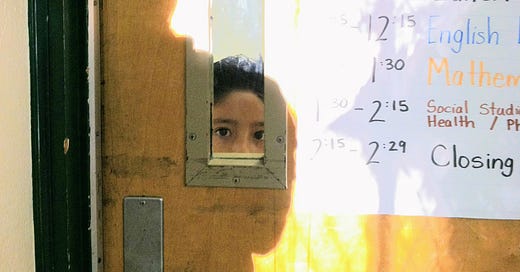To Door or Not to Door
I always kept my classroom doors open, but then the massacres started happening.
The tutoring business I offer my illustrious phonics-teaching talents to recently moved to a new office space equipped with transparent glass walls and doors.
I don’t mind the see-through tutoring experience except that sometimes I will look up from my teaching table and see a pair of eyes peeking from behind the one solid wall in the waiting room. The peeping Tom’s eyes inevitably belong to a paying mother making sure her student is paying attention. I wonder if she knows how creepy she looks?
Most classrooms are not designed to look like department store window displays. The most literal transparency many classrooms have is a small rectangle of bulletproof glass floating somewhere above the doorknob of a door. However, some teachers cover up this tiny bit of window in order to discourage random looky-loos from looking in despite the fact that doing so is a safety violation. I get it, though. Who wants to be constantly surveilled or gawked at while on the job?
Over the course of a couple of decades the decision to open or close, to lock or not lock, the classroom door has become extremely consequential. Dangerous. Deadly even.
Initially, when I started teaching, teachers were being asked to keep classroom doors open.
One of the best practices officially advised by the school district in their Code of Conduct for Teachers is “to avoid meeting individually with a student of any gender behind closed doors.” This recommendation is particularly relevant for LGBTQ teachers who are often held under suspicion by virtue of their gender or sexual identity.
In order to avoid innuendo, rumor, false accusations, or a reboot of the Salem Witch Trials, it’s better to keep your classroom doors wide open and avoid being left alone with students. Such one-on-one situations are not always easily managed but, with a special awareness, teachers can work hard to avoid accidentally being left alone with a kid.
As an educational professional it doesn’t feel good to operate under the suspicion of being a potential abuser, but it’s better to get over your hurt feelings and take precautions than to have to deal with any dangerous misunderstandings. I took always tried to take heed of closed doors.
In the later part of my career, particularly after dealing with some nefarious administrators, I kept my classroom door open as often as possible. My strategy of radical transparency was meant to protect me, my reputation, and my job. I welcomed anyone to come and take a look to see what we were doing in our classroom.
Many other teachers at my school (often female or straight) closed their classroom doors to avoid the prying eyes of administrators, loud kids in the hallway, or any number of legitimate distractions that happen at schools.
But I wasn’t going to take any chances; I kept my class doors open as much as possible.
But then, midway through my career, the school massacres started to happen: Sandy Hook, Parkland, Uvalde.
The horrendous school shootings made live shooter and lockdown drills more frequent and important than ever at elementary schools. They also made school campuses much more like maximum security prisons. Preventative protocols such as making sure exterior gates are locked while funneling all foot traffic through the main office became mainstays of campus security in this terrible new age.
But then even tighter security protocols began to instituted.
In 2017 San Bernardino special ed teacher Karen Elaine Smith was shot to death along with an 8 year old student in her classroom by her estranged husband walked into the school, through the main office, and killed her.
After that news story our local school site determined that we should now keep ALL school doors closed and locked. When I would leave mine open by accident or design, administrators would walk by, close it and lock it.
This felt crazy making. A teacher had to judge what was more likely to befall them, a false accusation of abuse or a young man with an assault rifle coming onto campus?
Teaching is becoming schizophrenically unbearable with the possibilities.
Reading the official report of the Uvalde school shooting the amount of wasted time trying to find keys to classroom doors that were probably unlocked is very disturbing.
I say “probably unlocked” because the responding officers spent over an hour trying to find keys to open doors they assumed were locked without ever trying the doorknobs. But as noted in the report, how would the shooter have had access to the classroom unless the classroom door was initially unlocked?
The gunman entered conjoined 4th grade classrooms 111/112 and shot 19 students and the 2 teachers.
Those wounded and still alive then waited for 77 minutes before law enforcement entered the classrooms to confront the shooter. One kid was on the phone telling the 911 dispatcher that his teacher was dying and asking for help. Meanwhile, officers were right outside the classroom in the hallway much of the time looking for master keys to unlock a door that was unlocked.
Observation 8 of the official report sums up the tactical error:
“The entry team assumed the door to rooms 111/112 were locked, based on information they received from officers who were on scene for a longer period of time. However, throughout the entirety of the incident, this assumption was never tested and the doorknob was never checked. Our analysis indicates that eight interior doors in the West Building were unlocked and discovered to be unlocked by responding officers during evacuations.”
Unlocked door or locked door, it never even mattered. Neither kept the teachers or students safe in this situation.
The killer used an unlocked door to enter while the police used the assumption of a locked door to delay their entry into the classroom.




